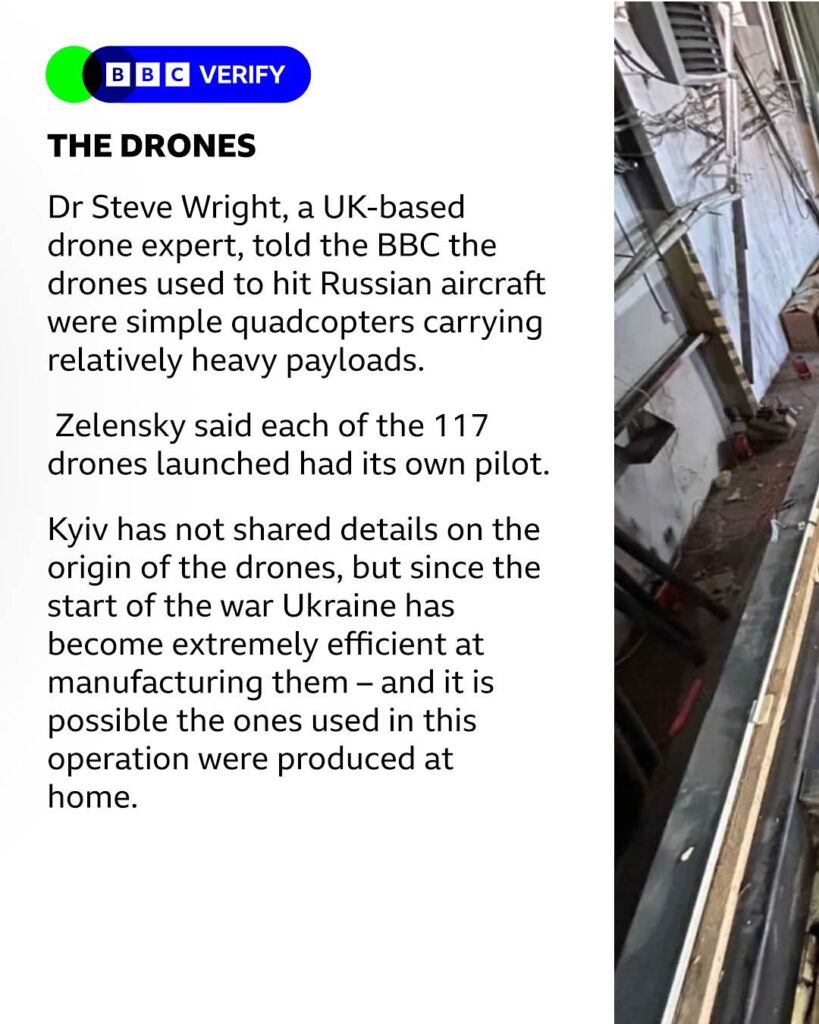
On 1 June, in a significant escalation of the ongoing conflict between Ukraine and Russia, more than 100 Ukrainian drones launched coordinated strikes on multiple Russian air bases deep inside Russian territory. The primary targets were nuclear-capable long-range bombers, key assets in Russia’s strategic military arsenal. This unprecedented drone assault has drawn intense international attention, highlighting the evolving nature of modern warfare and the deepening stakes in the Russia-Ukraine war.
The Scale and Scope of the Drone Attack
According to military sources and independent observers, the attack involved a massive swarm of drones targeting at least three major airbases located hundreds of kilometers inside Russia’s borders. These bases are known to host strategic bombers such as the Tu-95 “Bear” and Tu-160 “Blackjack,” aircraft capable of delivering nuclear payloads.
The use of over 100 drones simultaneously represents one of the largest drone offensives recorded in modern conflict, signaling Ukraine’s increasing capability to project power into Russian territory. The attack reportedly caused significant damage to airfield infrastructure, hangars, and several bombers themselves, though exact details remain classified by military authorities on both sides.
Strategic Implications of Targeting Nuclear-Capable Bombers

Targeting nuclear-capable long-range bombers is a bold move with far-reaching implications. These bombers are a critical component of Russia’s nuclear triad, giving it the ability to project nuclear deterrence globally. By striking such assets, Ukraine is sending a clear message: it can threaten even the most strategically significant elements of Russian military power.
The attack raises questions about Russia’s readiness and the vulnerability of its strategic forces. It may compel the Kremlin to reassess the security of its nuclear assets, potentially increasing tensions and risks of escalation.
Ukraine’s Growing Drone Warfare Capabilities

The June 1 drone strikes underscore Ukraine’s rapid advancement in drone warfare technology and tactics. Over the course of the conflict, Ukraine has effectively employed drones for reconnaissance, targeted strikes, and now, large-scale offensive operations deep inside enemy territory.
This development has been supported by international aid, with Western countries supplying Ukraine with advanced drones and related technology. Ukraine’s military innovation in drone swarming techniques — coordinating large numbers of unmanned aerial vehicles to overwhelm defenses — has proven effective in penetrating heavily fortified targets.
The success of this operation reflects both tactical ingenuity and the high stakes Ukraine faces in countering Russia’s military superiority.
Russia’s Response and Potential Countermeasures

In response to the drone strikes, Russian defense officials have condemned the attacks as a “flagrant violation” of their sovereignty and vowed to strengthen air defense systems around critical military installations. Early reports indicate that Russia is accelerating deployment of advanced anti-drone technologies and electronic warfare measures designed to jam and neutralize UAV swarms.
Russian media has also highlighted the resilience of their forces, downplaying the damage while warning of retaliatory strikes. There is concern that such escalation could provoke further military responses, raising the risk of wider conflict.
International Reactions and Concerns
The drone attack on Russian airbases has drawn varied reactions internationally. NATO officials have expressed concern about the increasing intensity and technological sophistication of the conflict, emphasizing the importance of diplomatic efforts to prevent further escalation.
Western governments supporting Ukraine have reiterated their commitment to providing advanced military aid but have also called for restraint on all sides to avoid a potential nuclear confrontation.
Meanwhile, analysts warn that attacks targeting nuclear-capable assets carry inherent risks, as miscalculations or misunderstandings could inadvertently lead to catastrophic escalation.
The Broader Context of the Russia-Ukraine Conflict
This drone strike must be understood within the broader context of the ongoing war that erupted in February 2022 when Russia launched a full-scale invasion of Ukraine. Since then, the conflict has evolved from traditional ground battles to include cyber warfare, drone operations, and information warfare, highlighting how modern conflicts are multidimensional.
Ukraine’s ability to strike deep into Russian territory indicates a shift in the strategic balance, showing that even powerful states with large conventional forces are vulnerable to asymmetric tactics like drone swarms.
The attack also signals Ukraine’s resolve to continue contesting Russian dominance and its determination to disrupt Moscow’s military capabilities wherever possible.
Potential Risks of Escalation
While the drone strike demonstrates Ukraine’s increasing military capabilities, it also raises significant risks. Targeting strategic nuclear assets is a red line for any nuclear-armed state and can provoke severe retaliation.
There is a delicate balance between military necessity and the imperative to avoid escalating to full-scale nuclear confrontation. Both sides appear aware of these dangers, but as tensions rise, the possibility of miscalculation grows.
What This Means for the Future of Warfare
The 1 June drone strike on Russian airbases offers a glimpse into the future of warfare, where unmanned systems and swarm tactics play a pivotal role. The ability of relatively smaller forces to threaten major strategic assets through technological innovation challenges traditional military doctrines.
As drone technology continues to evolve, we can expect more operations of this nature, where large numbers of UAVs are deployed to disrupt, disable, and destroy critical infrastructure with precision and speed.
Conclusion
The June 1 drone strikes by Ukraine on Russian air bases mark a significant escalation and a milestone in drone warfare history. By targeting nuclear-capable long-range bombers, Ukraine demonstrated both its growing military capabilities and its willingness to challenge Russia’s strategic deterrent.
As the conflict continues, the international community watches closely, aware of the grave risks involved but also the profound changes these events represent for modern military strategy and geopolitical dynamics.
The situation remains fluid, with the potential for further escalation or, hopefully, renewed diplomatic efforts to bring peace. For now, the drone strikes stand as a stark reminder of how warfare is changing and the high stakes involved for all parties.



